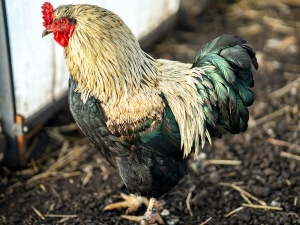
Chicken skin is usually white, yellow, and even black, so if your bird is starting to develop red skin you’d rightfully start to worry.
This article looks into why your beloved bird has suddenly developed a redness to its skin.
Table of Contents
Why is my chicken’s skin red?
Redness on humans usually means that we’ve caught a serious sunburn or that we are blushing, but this isn’t the same for chickens. Here is why your chicken has red skin:
Pecking:
Your bird may have red skin because it is very low on the pecking order and is being pecked to a point where its skin is becoming irritated and red.
The bird may be being bullied and pecked by other birds because it is smaller and can’t defend itself.
If your bird starts to get pecked for some reason, in order to keep it away from food, or is pecked while fighting, then all this pecking will turn the bird’s skin irritated and red.
The red skin of your bird may start to attract other birds who will peck the bird even more continuing the cycle.
What to do:
You can’t as a human change your bird’s position on the pecking order but you can investigate why the bird is being pecked and rectify it.
If the birds are stressed because of overcrowding and are pecking your weaker bird because of this then let the birds out of the coop sometime.
If the bird is being pecked because it is ill and the other flock members have attacked it because it is vulnerable then treat your sick bird and then return it back to the flock once recovered.
If the birds are pecking your bird because they lack protein in their diet then offer more protein in the flock’s diet.
Lice and mites:
Your bird may have red skin because it is pecking and scratching itself. If your bird becomes infected with external parasites, like lice or mites, then it may start to peck itself.
Mites and lice will bite your bird’s skin and suck the bird’s blood. This is very irritating to the chicken which will peck and scratch at its skin.
The bird will peck and scratch to the point where its skin goes red, to try to rid itself of the irritation.
What to do:
Take a look at your bird’s vent, and look at the other non-feathery parts of your bird’s body, to see if it is infected with parasites.
Note: The parasites may come onto the bird’s body at night when the birds go into the hen house to sleep so check at night as well, you may want to use a flashlight when doing this.
This can easily be remedied by using permethrin-based poultry dust on your bird. It is also advised that you use this poultry dust in the bird’s hen house or coop.
This treatment can be found in a dust or a spray application and you can also hang permethrin strips in your birdhouses for lice and mite control.
When applying this treatment to your bird, make sure that the treatment penetrates the bird’s skin.
Apply the treatment in your hen houses where the parasites hide like in the bird’s cages, side and end walls, nest boxes, and on stationary equipment.
Scald:
If your bird’s feet are turning red then your bird may be suffering from a condition called scald.
Scald develops on birds who walk on wet bedding and flooring. The ammonia on the floor burns the bird’s skin the same way that your skin would burn if it was exposed to a flame.
What to do:
The bird’s skin will have to repair itself in this case but you can keep the bird’s skin from getting worse by cleaning out the wet litter at the bottom of your chicken houses.
Add a new clean layer of fresh litter after you’ve cleaned the old litter out.
If you can’t replace the litter then allow the litter to dry out by running fans in the coop.
If you enjoyed this article then you may also be interested in other bird related articles. Here are some articles that you may be interested in: Why Is My Chickens Skin Green?, Why Is My Chicken’s Skin Yellow?, Why Is My Chickens Face White, Chicken Has Lump Under Eye, Chicken Swollen Under Beak, Red Skin On Chicken Head, Why Is My Chickens Face Red?, Why Does My Chickens Face Change Color?, Chicken Pale Around Eyes

